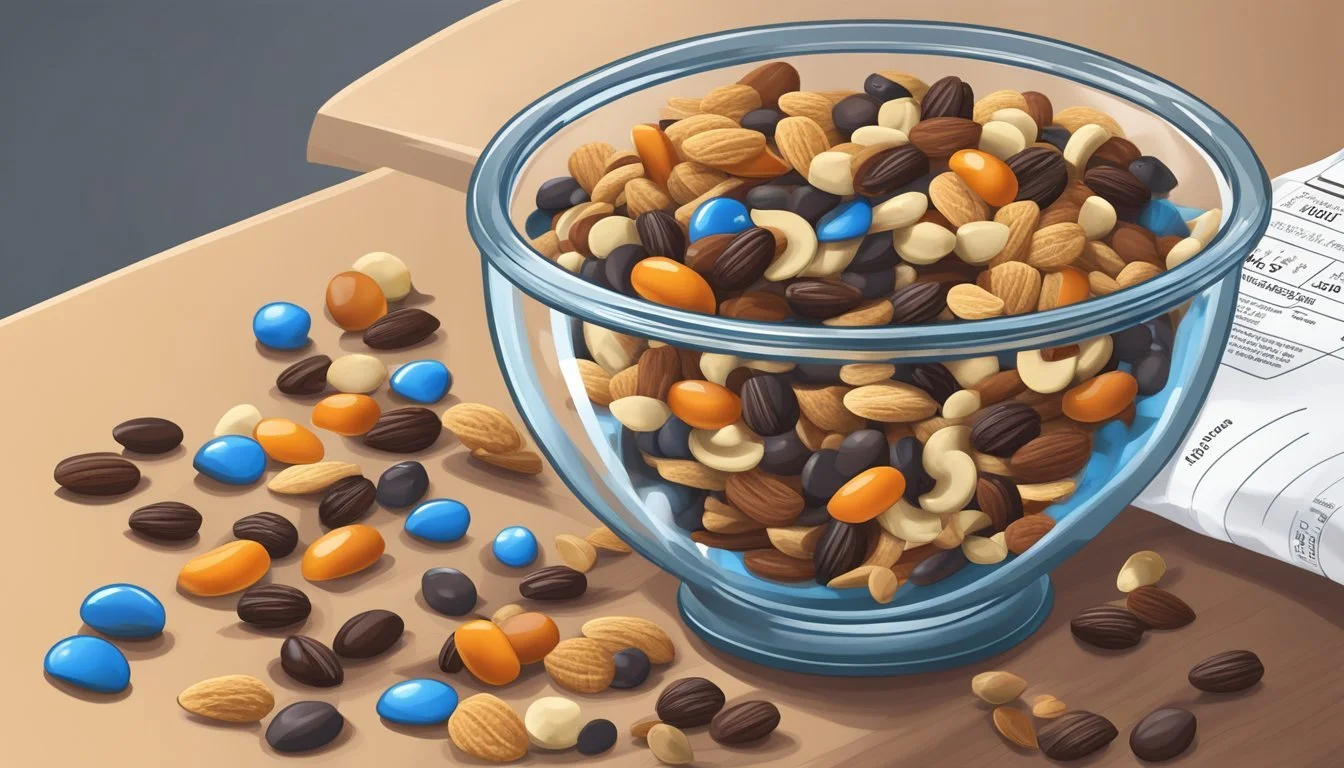How Much Trail Mix Per Day Is Too Much?
Understanding Portion Limits
Trail mix has long been the go-to snack for outdoor enthusiasts seeking a burst of energy while on the move. Its convenience and high energy content make it an alluring choice for activities like hiking, where carrying light yet nutritious provisions is essential. Typically packed with a blend of nuts, seeds, dried fruits, and sometimes chocolate or candy pieces, trail mix is not only flavorful but also serves as a potent source of energy, thanks to its robust composition of fats, proteins, and carbohydrates.
Despite its reputation as a healthy snack, the calorie-dense nature of trail mix warrants attention to portion size. The mix is often consumed in larger amounts than recommended, leading to excessive calorie intake. To maintain its status as a healthy snack, particularly for those not engaged in vigorous outdoor activities, it is advisable to consume it in moderation.
A standard serving size for trail mix is generally around a quarter cup, with many dietitians suggesting to keep snack sizes between 150-200 calories. Striking the right balance is crucial as overconsumption can easily counteract the health benefits, especially in a sedentary setting. Conscious consumption ensures that trail mix can be included as part of a balanced diet, providing sustained energy and nutritional benefits without the risk of calorie overload.
Nutritional Profile
Trail mix is a nutrient-dense snack comprised primarily of nuts, seeds, and dried fruit. It offers a substantial energy boost due to its caloric content, macronutrients profile, and myriad of vitamins and minerals.
Caloric Content
The calorie count in trail mix can be significant, as a 1.5 oz (42 gram) serving typically contains around 203 calories. Due to high-calorie ingredients like nuts and dried fruit, trail mix is energy-rich, making it a satisfying choice for hiking or extended periods of physical activity. However, for those mindful of calorie intake, especially during weight loss efforts, careful attention to portion size is essential.
Macronutrients
Protein: A mix can provide around 4 grams of protein per ounce, contributing to muscle growth and repair.
Fats:
Healthy Fats: Nuts like almonds, walnuts, and cashews contribute unsaturated fats.
Saturated Fats: Usually lower in trail mix, around 1.5 grams per serving.
Fiber: With ingredients such as seeds and dried fruit, fiber content is notable. For example, a 1.5 oz serving may contain about 2 grams of fiber.
Providing sustained energy, trail mix is rich in both protein and fiber, while the type of fat predominantly found in nuts is associated with heart health.
Vitamins and Minerals
Trail mix is an excellent source of various vitamins and minerals. Nuts and seeds such as pumpkin and sunflower offer nutrients like vitamin E, magnesium, and zinc. The presence of dried fruit increases the mix's content of vitamins, specifically antioxidants, while nuts like almonds and pistachios provide calcium and potassium. The omega-3 fatty acids, particularly in walnuts, contribute to the overall nutritional value of the mix.
Health Considerations
Consuming trail mix in moderation can offer health benefits, yet excessive intake may lead to potential health concerns due to added sugars, fat content, and sodium levels. The following subsections detail specific considerations to keep in mind.
Added Sugars and Fat
Trail mix often includes ingredients like chocolate, dried fruits, and nuts that can vary in sugar and fat content. Dried fruits can have a high glycemic index, leading to a quick rise in blood sugar levels, while some chocolate, especially if it's not dark chocolate, may contain added sugars. Nuts and seeds provide healthy unsaturated fats, yet they are calorie-dense, and some trail mixes contain saturated fats due to ingredients like chocolate or certain nuts.
Healthy Fats: Nuts and seeds offer a mix of mono- and poly-unsaturated fats.
Saturated Fats: Pay attention to the amount of saturated fats included, aiming for the least.
Sodium Content
While nuts and seeds inherently contain some sodium, the concern mainly arises with salted nuts. High sodium consumption can lead to health issues, including raised blood pressure, hence it's important to choose trail mixes with unsalted nuts to regulate adequate intake of sodium.
Low Sodium: Choose mixes with unsalted nuts to maintain a healthier sodium level.
Allergies and Sensitivities
Individuals should be mindful of allergy-inducing ingredients found in trail mixes, such as nuts and seeds. Additionally, gluten cross-contamination can be a concern in certain snack mixes, necessitating a careful review of the ingredients list by those with sensitivities.
Allergen Information: Always check packaging for potential allergens.
Cross-Contamination: Those with sensitivities should ensure mixes are free from cross-contamination risks.
Appropriate Portions
Consuming trail mix can be a nutritious choice when it comes to snacking, but it's essential to be mindful of portion sizes. The high calorie and nutrient-dense components make it easy to overeat.
Recommended Serving Sizes
A standard serving size for trail mix is typically one ounce (about ¼ cup). This portion approximately contains:
130-140 calories
8-9 grams of fat
12-13 grams of carbohydrates
2 grams of fiber
4 grams of protein
0-25 mg of sodium
One should aim to adhere to this serving size to maintain energy balance and moderation in their diet.
Effects of Overconsumption
Exceeding recommended serving sizes can contribute to several health risks:
Weight Gain: Trail mix is a high-calorie food. Regularly consuming large portions can lead to a caloric surplus and subsequent weight gain.
High Sodium Levels: Some trail mixes contain added salt, leading to high sodium intake if overconsumed.
Imbalance: Consistently large portions can create an imbalance in the diet, with excessive intake of certain nutrients at the expense of others.
Trail Mix Varieties
When choosing trail mix, consumers face a plethora of options, each with distinct flavors and ingredients. The balance of sweetness and saltiness often dictates the popularity of a mix, hitting the spot for those diverse cravings.
Commercial Mixes
Commercial trail mixes come in an array of flavor profiles and combinations. They commonly include ingredients such as nuts, dried fruits, chocolate chips, and occasionally candy pieces. While some mixes are marketed as a healthy trail mix, offering a balance of good fats, proteins, and fibers, others cater to the sweet and salty cravings by adding more chocolate or sweetened dried fruits.
Notable varieties often contain:
Nuts like almonds, cashews, and peanuts
Seeds such as pumpkin or sunflower seeds
Dried fruits including raisins, cranberries, or exotic mango and pineapple
Various forms of chocolate, with dark chocolate being a healthier choice due to its lower sugar content
Homemade Mix Recipes
The customizable nature of trail mix shines when it comes to homemade recipes. Individuals can tailor their mix to cater to their personal taste preferences and nutritional needs. A common, balanced recipe might use a 3:2:2 ratio of nuts, dried fruits, and dark chocolate to ensure a mix that is both flavorful and health-conscious.
Essentials for a customizable homemade recipe are often:
A selection of nuts such as walnuts, almonds, or pistachios for a heart-healthy fat source.
Dried fruits like apricots, apples, and raisins provide natural sweetness and fiber.
Add-ins, including dark chocolate chunks for antioxidants, are a treat within the mix.
By carefully selecting the components, one can create a trail mix that complements their diet, satisfying cravings in a healthier way compared to some store-bought options that may contain excess sugars and sodium.
Incorporating Trail Mix into Diet
Trail mix can be a convenient and healthy snack option that provides energy, particularly for people who enjoy the outdoors and activities such as hiking. Portion control is essential to ensure the consumption is within the appropriate calorie range for an individual's dietary needs.
As a Snack Option
Trail mix, composed of nuts, seeds, and dried fruits, offers a nutrient-dense choice for snacks. One can control portions by pre-measuring servings; a typical serving is about a handful, which generally equates to roughly a quarter of a cup or approximately 150 to 200 calories. Preparing individual servings can prevent overeating and makes it easy to grab a portion when in need of a quick energy boost.
Alongside Physical Activities
For hikers and those engaging in physical exercise, trail mix serves as a convenient energy source. The combination of carbohydrates from dried fruits and the sustained energy from nuts helps maintain endurance during activities. When participating in strenuous outdoor pursuits, a slightly larger portion may be appropriate, but one should still remain mindful of the total caloric intake in the context of their full day's diet.







